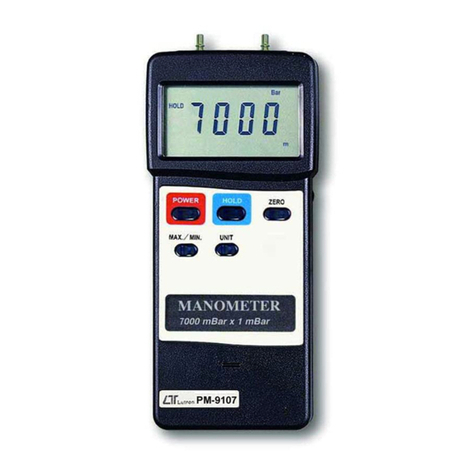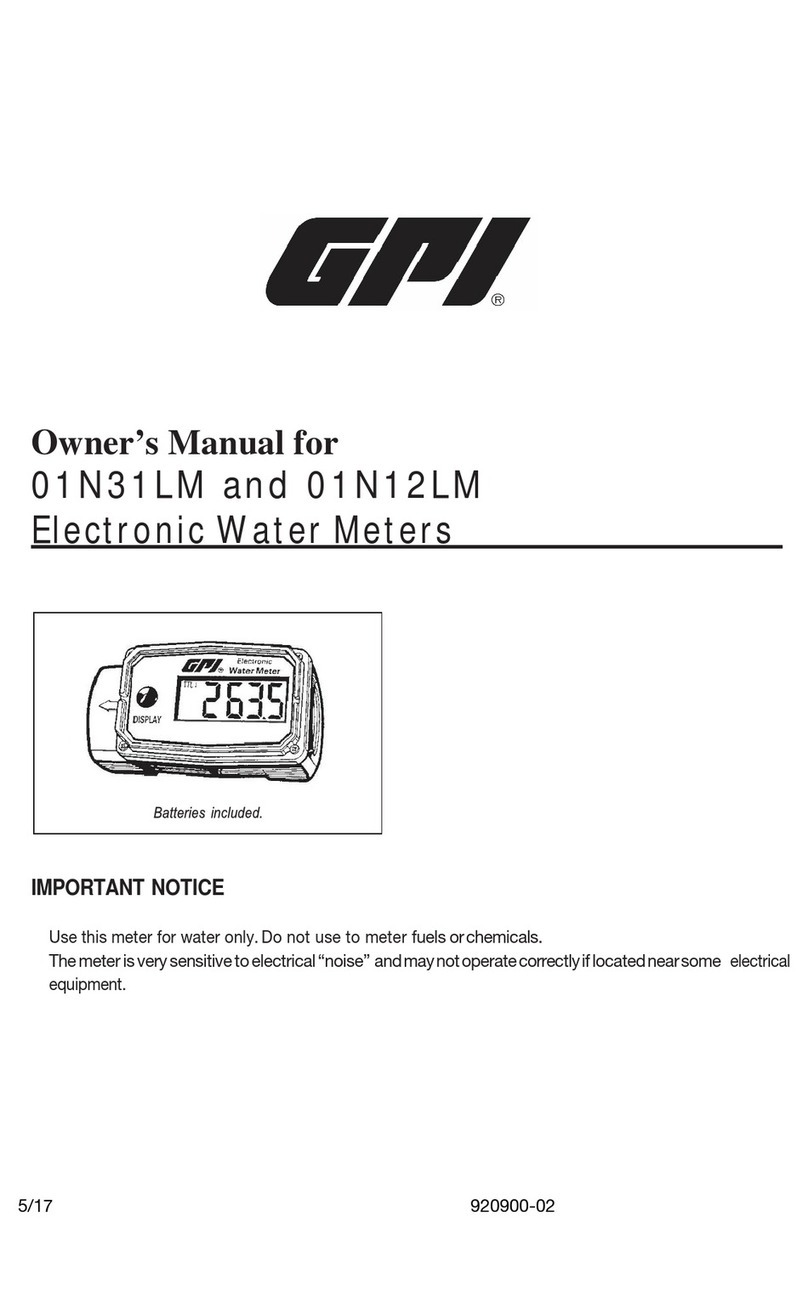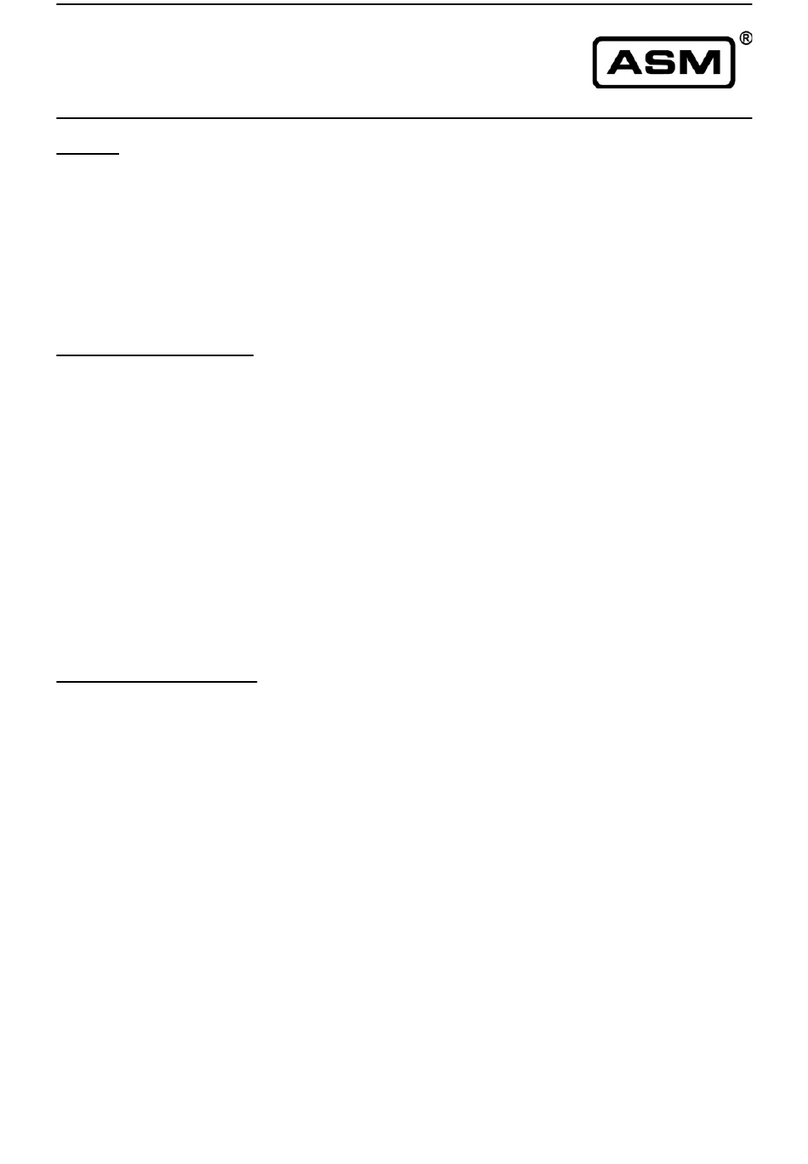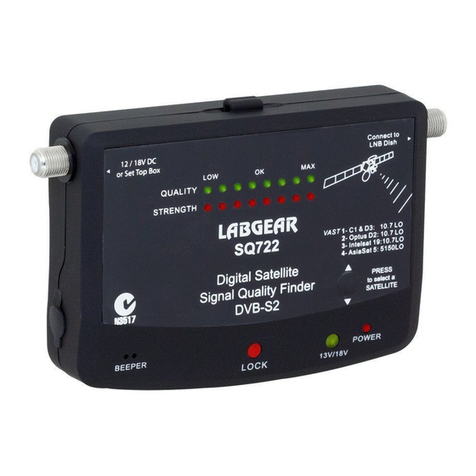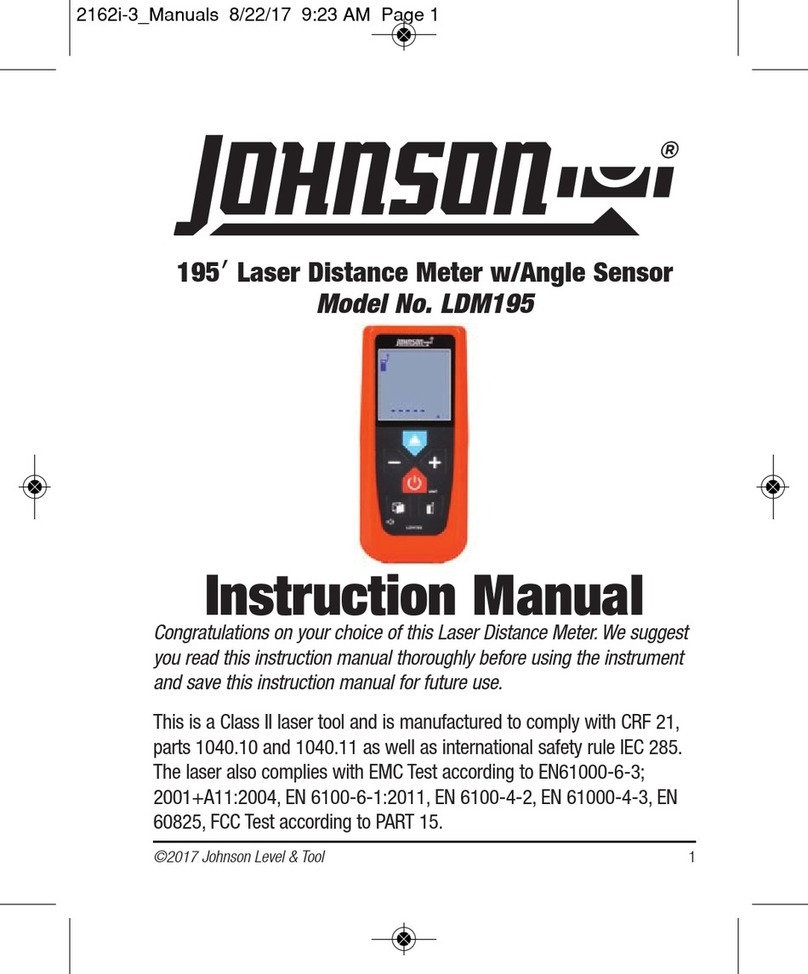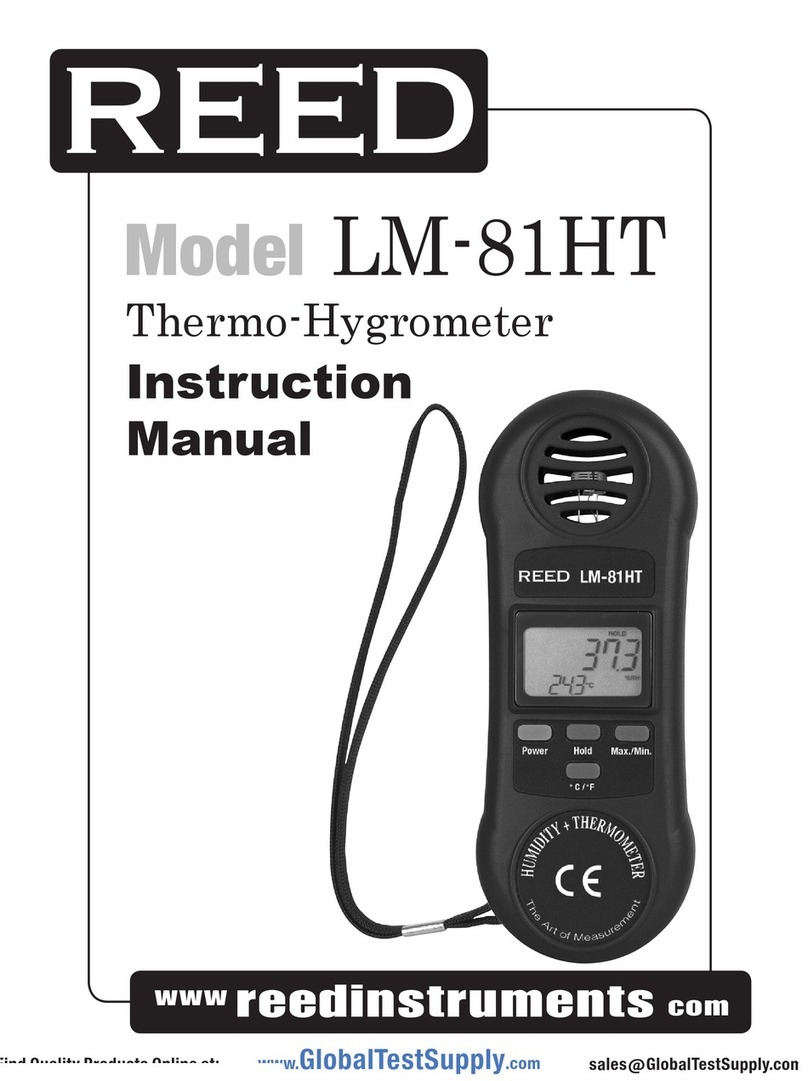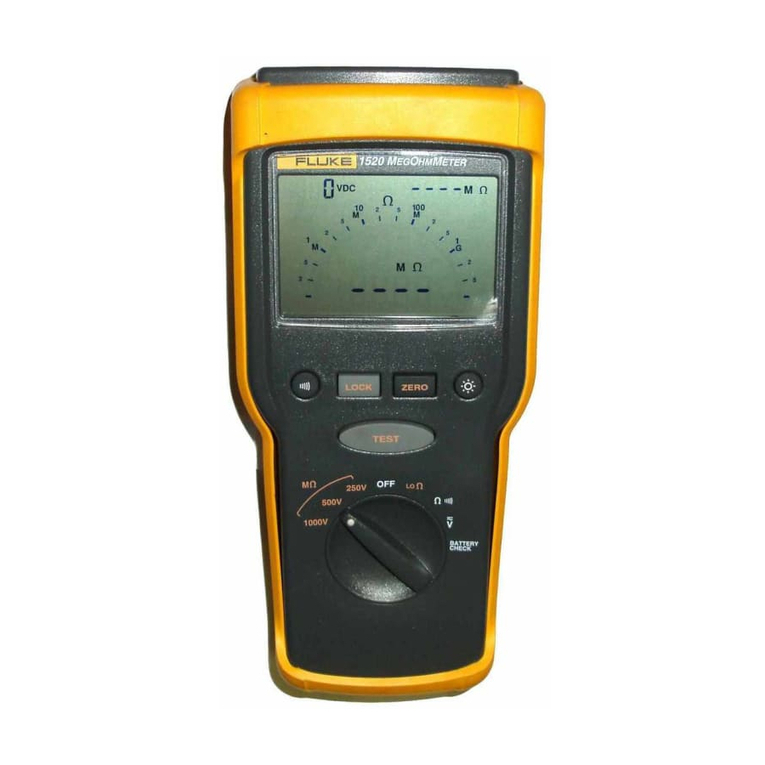GPG C270 User manual

C270
CONDUCTIVITY MONITOR
OPERATION GUIDE

1
CONTENTS
1.
INTRODUCTION.......
2
2.
FEATURES AND TECHNICAL SPECIFICATIONS.
…
2
2.1
Features........
2
2.2
Technical S ecifications........
2
3.
INSTALLATION.....
2
3.1
Dimension........
3
3.2
Panel Cut-out.......
4
3.3
User Interface and Descri tion..
4
3.4
Connection...........
6
4.
SETTING AND OPERATION......
7
4.1
Switch Measuring and Setting Mode..................
8
4.2
Menu Structure........
8
4.3
Parameter Setting and O eration........
11
4.3.1
Set Alarm........
11
4.3.2
Calibration..........
12
4.3.3
Tem erature Com ensation....
14
4.3.4
Set Current Out ut........
15
4.3.5
Measurement Mode......
17
4.3.6
Select cell constant.......
18
4.3.7
Set TDS coefficient.......
18
4.3.8
Restore Factory Setting....
18
5.
ERROR CODES...........
19
6.
SENSOR.....
19
7.
WARRANTY...
22
8.
STANDARD CONFIGURATION.....
22
9.
OPTIONAL CONFIGURATION.......
22

2
C270
Intelligent On-line Conducti ity Monitor
1. INTRODUCTION
The C270 is a micro rocessor controlled conductivity measurement
instrument. The unit utilizes a multifunction LCD to dis lay readings and
rovide feedback to the user. It is available with different o tion to
rovide fully configurable control, alarm and feedback with u to two
relays and 4-20mA current out ut sources.
2. FEATURES AND TECHNICAL SPECIFICATIONS
2.1 Features
(1) 4 LCD digital with back-lit dis lay
(2) Measured conductivity, resistivity, TDS, tem erature
(3) 0 ~ 100℃ automatic/manual tem erature com ensation
(4) Manual or Automatic buffer adjustment
(5) Restore factory setting function is available
(6) Galvanic se aration between in uts and out uts and su ly voltage
(7) Different in ut for excellent noise rejection
(8) High and low rogrammable alarm, 250V/10A relay out ut
2.2 Technical Specifications
(1) Ranges of measurement :0~18 M Ω·cm or 0~19.99uS/cm,
0~999.9uS/cm, 0~9999uS/cm, 0~100mS/cm,0~10000 m
(2) Accuracy:±0.5 F.S / ±0.2℃
(3) Linearity:±0.1% of range
(4) Re eatability:±0.1% of range
(5) Tem erature com ensation ty e:Auto / manual 0℃ to 100℃
(6) Alarm Out ut:Two relays out uts (250V/10A),full range with
hysteresis adjustable
(7) Current out ut:DC 4~20mA,O to-isolated out uts,( 750Ω Max.

3
load)
(8) Ambient O erating tem erature:-10~+55℃
(9) Humidity:≤95%
(10) Power su ly:AC110 ~220V,50~60Hz
3. INSTALLATION
The anel-mounting version is designed to be flush mounted and sealed
in a square cut-out in a anel, and is held in lace with the two screw
clam s rovided.
3.1 Dimensions
Figure 2 : overall dimensions panel-mounting
Figure 1 : installation diagram

4
3.2 Panel Cut-out
¨The anel cut-out for mounting the unit should be 92 mm x 92 mm
(+1.0– 0.0).
¨Two screw clam s are su lied and are fitted from the back of the
instrument
3.3 User Interface and Description
Front anel descri tion:
(1) LCD digital Monitor,dis layed the measured values,and can also
Figure
3
:
cut
-
out
d
iagram
Figure 4: front panel diagram

5
be dis layed rom t function, arameter values and error codes in
interactive.
(2) TDS indicator light. When the light is lit in the measuring state,means
the measured value is TDS; When the light is lit in the setting state,
means the in ut arameter is TDS.
(3) H alarm light,Under the conditions of setting high alarm, when the
measured H value of the solution is higher than the value of High
alarm, the H alarm light will be turned on and the high relay (N/O)
close; When the measured H value of the solution is lower than the
value of High alarm, furthermore lower than the hysteresis, the H
alarm light will be turned off and the high relay (N/O) o en.
(4) L alarm light,Under the conditions of setting low alarm, when the
measured H value of the solution is lower than the value of low alarm,
the L alarm light will be turned on and the low relay (N/O) close; When
the measured H value of the solution is higher than the value of low
alarm, furthermore higher than the hysteresis, the L alarm light will be
turned off and the low relay (N/O) o en.
(5) SET indicator light, the light will be turned on when entering the
setting state.
(6) uS/cm indicator light. When the light is lit in the measurement state,
means the measured value is conductivity, and unit is uS/cm.
(7) mS/cm indicator light. When the light is lit in the measurement state,
means the measured value is conductivity, and unit is mS/cm.
(8) MΩ
ΩΩ
Ω·
··
·cm indicator light. When the light is lit in the measurement state,
means the measured value is resistivity, and unit is MΩ·cm.
(9) ℃
℃℃
℃ indicator light. When the light is lit in the measurement state,
means the measured value is Tem erature; When the light is lit in the
setting state, means the in ut arameter is Tem erature.

6
(10)
MENU
,Press the
MENU
key to enter or exit the setting state.
(11)
DOWN
,In the setting state, using the
DOWN
key the user can
cycle through the next menu. To adjust a value, the
DOWN
key is
used to select a digit
.
(12)
UP
,In setting state, using the
UP
key the user can cycle
through the front menu. To adjust a value, the
UP
key is used to
increment the digit
.
In measurement state, the
UP
key is used
to switch the dis lay of tem erature or conductivity/resistivity/TDS.
(13)
ENTER
key is the enter button to confirm enter the menu and
store the setting arameters.
3.4 Connection
Connection terminals wiring directions:
(1) Conductivity sensor line A (red)
(2) Conductivity sensor line B (yellow or white)
(3) Tem erature sensor 1 (blue or brown)
(4) Tem erature sensor 2 (black)
(5) 4~20mA current out ut (+)
(6) 4~20mA current Out ut (-)
Figure 5: connection terminals diagram

7
(7) S are
(8) S are
(9) S are
(10) High/Low alarm relay(Common)
(11) S are
(12) High alarm relay(N/O, normally o en)
(13) Low alarm relay(N/O, normally o en)
(14) S are
(15) S are
(16) S are
(17) S are
(18) S are
(G) Ground
(L2) S are
(L1) Power su ly terminal: Connect AC110 ~ 220V
(N) Power su ly terminal: Connect the ower su ly hase
★
CAUTION ! :
The s ecified erformance of the C270 is entirely de endent on correct
installation. For this reason, the installer should thoroughly read the
instructions before attem ting to make any electrical connections to the
unit.
4. SETTING AND OPERATION
After installation, check the connection is correct, then ut the sensor
into the test solution, reheat for 10 minutes, you can erform the
following o erations.

8
Set high alarm hysteresis
4.1 Switch Measuring and Setting Mode
Instrument has two states: measuring state and setting state. After
owering u the device enters the measuring state automatically. In the
measuring state, ress
MENU
to enter the setting state. In the setting
state, ress
MENU
to return to the measuring state.
4.2 Menu Structure
(Manual Tem erature com ensation
)
Set high alarm value
Set
low
alarm
value
Set
low
alarm
h
ysteres
is
Set
T
em erature com ensation coefficient
Set Manual tem erature com
ensation
value
Auto calibration low
Tem . value
Auto calibration high
Tem . value
(Auto Tem erature com ensation
)

9
(The in ut for current out ut is conductivity)
(
Manual set
low relay close)
(
Manual set
low r
elay o en)
(
Manual set
high relay close)
Set current out ut start value
Set current out ut
end
value
Set conductivity start value for
current out ut
Se
t conductivity end value for
current out ut
Set tem erature start value for
current out ut
Set tem erature end value for
current out ut
Manual set
current out ut
value
(
Manual set
high relay o en)
(The in ut for current out ut is tem erature)

10
( ut the sensor into standard buffer)
S
elect cell constant k=
0.01
(Dis lay
tem erature
value)
S
elect cell constant k=
0.1
0
S
elect cell constant k=1.00
(Dis lay
TDS
value)
(Dis lay
r
esistivity
value)
(Dis lay conductivity value)
Restore factory setting
S
elect cell constant k=
10.0
Sensor manual calibration
Calibrate
current out ut
Auto Return
Set TDS Coefficient
(0.4
-
1.0)

11
4.3 Parameter Setting and Operation
4.3.1 Set Alarm
The C270 monitor has two alarm out uts designated high alarm(H) and
low alarm(L). The alarm value and alarm hysteresis can be set within
the currently selected measuring range.
*Note: The setting should meet AH-EH≥AL+EL
Alarm Relay
During normal o eration when the alarm is not active, the alarm out ut
will be in its NORMAL condition, the N/O (normal o en) contact will be
o en. When the alarm is active, the alarm out ut will be in its ALARM
condition and therefore the N/O contact will be closed.
Alarm Hysterisis
In a normal condition an alarm turns on and off at the same value. For
exam le, if a high alarm turns on at 2000 uS/cm the alarm occurs when
the reading increases to 2000 uS/cm. When it decreases through 2000
uS/cm the alarm turns off.
Some a lications may demand that the alarm turns off at a different
Code Content Set range Unit
AH High alarm value 0~18.00/0~100 MΩ·cm /
mS/cm
EH High alarm hysteresis
0~18.00/0~100 MΩ·cm /
mS/cm
AL Low alarm value 0~18.00/0~100 MΩ·cm /
mS/cm
EL Low alarm hysteresis
0~18.00/0~100 MΩ·cm /
mS/cm
table1 alarm value setting program content

12
value, for a high alarm this would be value lower than the alarm value,
and for a low alarm this would be a value higher than the alarm value.
The hysterisis value determines the difference between the alarm switch
on oint and the alarm switch off oint. In the case of a high alarm,
hysterisis causes the alarm to turn off at a value that is less than the
alarm value. For a low alarm, hysterisis causes the alarm to turn off at a
value greater than the alarm value.
4.3.2 Calibration
Calibration Inter als
The C270 Monitor and Sensor combination once calibrated will require
calibration checking/recalibration at 3-6 monthly intervals, however this
does de end on the a lication. The calibration of the instrument can be
effected by seasonal variations in the measured effluent, however only
knowledge of the a lication can determine the re-calibration interval
required.
4.3.2.1 CAL—conducti ity sensor manual calibration
Pre aring For Calibration:
Figure 6 alarm with hysterisis

13
Value known conductivity buffer 100ml;
Pure water 300~500ml;
Use ure water to wash the sensor, and then make it dry;
Use thermometer to measure the tem erature of buffer;
Select manual tem erature com ensation in the instrument menu and
in ut the tem erature value of buffer, set the tem erature
com ensation coefficient is 0.
S ecific o erations: select CAL in the menu and ut the dry and clean
sensor into the known conductivity buffer solution, ress
ENTER
to enter
its rogram, then the instrument dis lays the measured value of the
solution, and in flashing mode which is different from the measurement
states. After the measurement data is stable then ress
ENTER
again,
now only the first digit flashing in the dis lay data means it is modify bit.
Press
DOWN
to choose the modification bit, ress
UP
key to modify
the data, make the dis lay value as same as the conductivity value of the
solution, ress
ENTER
to store the calibration data(This value is stored
even after ower failure), and return to the setting state.
4.3.2.2 C0、
、、
、C100—temperature calibration
C270 has tem erature measurement function, for the automatic
tem erature com ensation, and also can be dis layed on the monitor.
Tem erature calibration requires a high and a low constant tem erature
environment. Such as ice water mixture (0℃) and boiling distilled water
(100℃). C0 is used to calibrate 0℃. select C0 in the menu and ut the
sensor into 0℃ environment, ress
ENTER
to store the calibration
data
, and return to the setting state. The Method of calibrate 100℃ is as
same as calibrate 0℃.

14
ε
= ×100%
cond.35-cond.25
able2 temperature calibration program content
Code
Content Direction
C0 Auto calibrate tem erature=0℃ Use Ice water mixture (0℃) to calibrate
C100
Auto calibrate tem erature=100℃
Use boiling water (100℃) to calibrate
4.3.3 Temperature Compensation
4.3.3.1 CC—auto/manual temperature compensation switch
C270 has Auto and manual tem erature com ensation function. The
user can select between two modes of com ensation by the CC in the
menu. Press
ENTER
into CC and dis lay CC0 or CC1. CC0 is Auto
tem erature com ensation, CC1 is manual tem erature com ensation.
Press
UP
to switch it, then ress
ENTER
to store and return to the
setting state.
4.3.3.2 C--C—set temperature compensation coefficient
The tem erature com ensation coefficient is different for each ty e of
solution, so the tem erature com ensation coefficient is designed to be
adjustable(25 as the reference℃), and the range is 0~±10%/℃. Select
C--C in the menu, ress
ENTER into i
t and dis lay the original value,
use
DOWN
and
UP
to modify it, then ress
ENTER
to store and
return to the setting state. The tem erature com ensation coefficient
works both in automatic and manual tem erature com ensation.
he Calculation Method of coefficient
Remark:cond.25=the conductivity value at t=25℃;
cond.35=the conductivity value at t=35℃
c
ond.
25
(35
-
25)

15
able3 temperature compensation program content
4.3.3.3 CH—set manual temperature
In this mode the instrument should be set with the “CC1” and the
user can set the solution tem erature (
0~100℃)
in the CH menu. Press
ENTER
into CH and dis lay the original value, use
UP
and
DOWN
to modify it, then ress
ENTER
to store and return to the setting state.
Code
Content Direction
CC Auto/manual tem . com ensation switch
0=Auto/1=manual
C--C
Tem . com ensation coefficient setting Range:
0~±10%/
℃
CH Manual tem erature setting Range:
0~100℃
4.3.4 Set Current Output
C270 has one 4~20mA current out ut. The user can select the in ut
source: conductivity or tem erature. And the current out ut can be set
work over the whole range of the in ut source.
The out ut can be set work over the whole of selected measurement
range (curve1) or a ortion of it by setting of the out ut start and end
values (curve2). It is also ossible to configure the out ut to work reverse
to normal, i.e. a 4 – 20 mA out ut where 20 mA corres onds to the zero
Figure 7 Current span curve

16
able6
set current output
dis lay value and 4 mA corres onding to the full scale value. (curve3).
4.3.4.1 FSIS、
、、
、FSIE—set current output start and end alue
Select FSIS in the menu, ress
ENTER
into it and dis lay the original
current out ut start value, use
DOWN
and
UP
to modify it, then
ress
ENTER
to store and return to the setting state.
The same method select FSIE
to set the current out ut end value.
4.3.4.2 FSI—select the input for the current output
Select FSI in the menu, ress
ENTER
into it and dis lay FS 0 or FS 1.
FS 0 is conductivity as the in ut, FS 1 is tem erature as the in ut.
Press
UP
to switch it, then Press
ENTER
to store and return to the
setting state.
Code Content Direction
FSIS
Current out ut start value
4.00~20.00 mA
FSIE
Current out ut end value
4.00~20.00 mA
FSI
The in ut for the current
out ut
0: conductivity
1: tem erature
4.3.4.3 FIgS、
、、
、FIgE、
、、
、FICS、
、、
、FICE—set input alue range for the current
output
After selecting the in ut arameters, you can set its start value and end
value. Select FIgS in the menu, ress
ENTER
into it and dis lay the
original conductivity start value, use
DOWN
and
UP
to modify it,
then ress
ENTER
to store and return to the setting state. The same
method select FIgE
to set the conductivity end value.

17
Likewise, select FICS and FICE to set the tem erature start and end
value for current out ut.
Code Content Range
FIgS
Conductivity start value
0~9999uS/cm (k=1)
FIgE
Conductivity end value
0~9999uS/cm (k=1)
FICS Tem erature start value
0~100℃
FICE Tem erature end value 0~100℃
4.3.5 SHSP—Measurement Mode
C270 has conductivity, resistivity, TDS and tem erature four modes of
measurement and dis lay functions, it can be selected in the SHSP
rogram.
Select SHSP in the menu, Press
ENTER
into it and dis lay SH 0 or
SH 1 or SH 2 or SH 3. SH 0 is conductivity mode, SH 1 is resistivity
mode, SH 2 is TDS mode, SH 3 is tem erature mode. Press
UP
to
switch it, then Press
ENTER
to store and return to the setting state.
The indicator light also changes to indicate that the dis lay state
changes. The corres onding arameters in the setting also will
automatically change.
*NOTE:
::
:The sensor should be changed when switch the measurement
mode.
C
ode
C
ontent
I
ndicator light
C
ell constant
S
H
0
Dis lay
conductivity
value
u
S
(mS)
/cm
lights
K
=0.01/0.1/1.0/10
S
H
1
Dis lay
resistivity value
M
Ω
·
cm
lights
K
=0.01
S
H 2
Dis lay
TDS value
T
DS
lights
K
=0.1/1.0
S
H 3
Dis lay
Tem
erature
value
℃
℃℃
℃
lights
K
=0.01/0.1/1.0/10
In addition, when in measurement mode ress
UP
it can dis lay
able8
measurement
Mode
able7
set input range for the current output

18
the tem erature value, and the Tem . indicator will light. After a few
seconds automatically return to the original measurement mode.
4.3.6 CEL—Select cell constant
C270 can choose four models of sensor according to the
measurement range, it can be selected in the CEL rogram.
Select CEL in the menu, Press
ENTER
into it and dis lay 1.00 or 0.10
or 0.01 or 10.0. Press
UP
to switch it, then Press
ENTER
to store
and return to the setting state. The corres onding arameters in the
setting also will automatically change.
C
ode
C
ontent
Measurement Range
1.0
0
C
hoose constant=1.0 sensor
0~99
99uS/cm
or 0~10000 m
0.
1
0
C
hoose constant=0.1 sensor
0~99
9
.
9uS/cm
or 0~1000 m
0.01
C
hoose constant=0.01 sensor
0~
1
8 M
Ω
·
cm
or 0~19.99uS/cm
10.0
C
hoose constant=10.0 sensor
0~
2
0m
S/cm
4.3.7 Ctds—Set TDS coefficient
When SHSP = SH 2, select Ctds in the menu. The TDS coefficient is
different for each ty e of solution, so the user can choose the coefficient
between 0.4~1.0, then ress
ENTER to confirm.
4.3.8 FACt—Restore Factory Setting
Select FACt in the menu, ress
ENTER
into it and dis lay HHHH. At
this moment the instrument is being restored factory setting, about 10
seconds it will automatically returns to FACt, restore factory setting is
com leted. After this rocess, all value the user set before becomes the
factory calibration value. This function is generally used for re lace with
new sensor or data confusion. Generally after restored factory setting, it
need recalibration before using.

19
5. ERROR CODES
When the instrument detects an error condition, an error code will be
dis layed. All the error codes are described below.
6. SENSOR
We use foreign advance technology to manufacture our conductivity
sensor. The quality of the sensor is excellence and it can be used in
industry rovince with all kind of conductivity monitor.
6.1 Sensor Features
High sensitivity and accuracy with reliability and durability
Stainless material
Quickly res onse(within two seconds) and stability
Unique structure reventing the sensor from ollution and blockage
Easy to assemble and clean
Code
Content
Solve methods
Er01 Measurement value
out of range
Check whether the
choice of cell constant is
suitable and re lace the correct one
Er02 Sensor signal failure
1. Check whether the sensor connected with
the monitor ro erly
2. Enter menu FACt to restore factory setting
3. Suggest check or re lace the sensor
Er03 Tem erature sensor
failure
1. Check whether the tem erature sensor
connected with the monitor ro erly
2. Check whether the tem . com ensation
(menu CC) setting correct
Er04 Alarm setting error
1. Check whether the alarm setting correct,
setting should meet AH-EH≥AL+EL
2. Enter menu FACt to restore factory setting
able
9
e
rror
codes
Table of contents
Other GPG Measuring Instrument manuals
Popular Measuring Instrument manuals by other brands
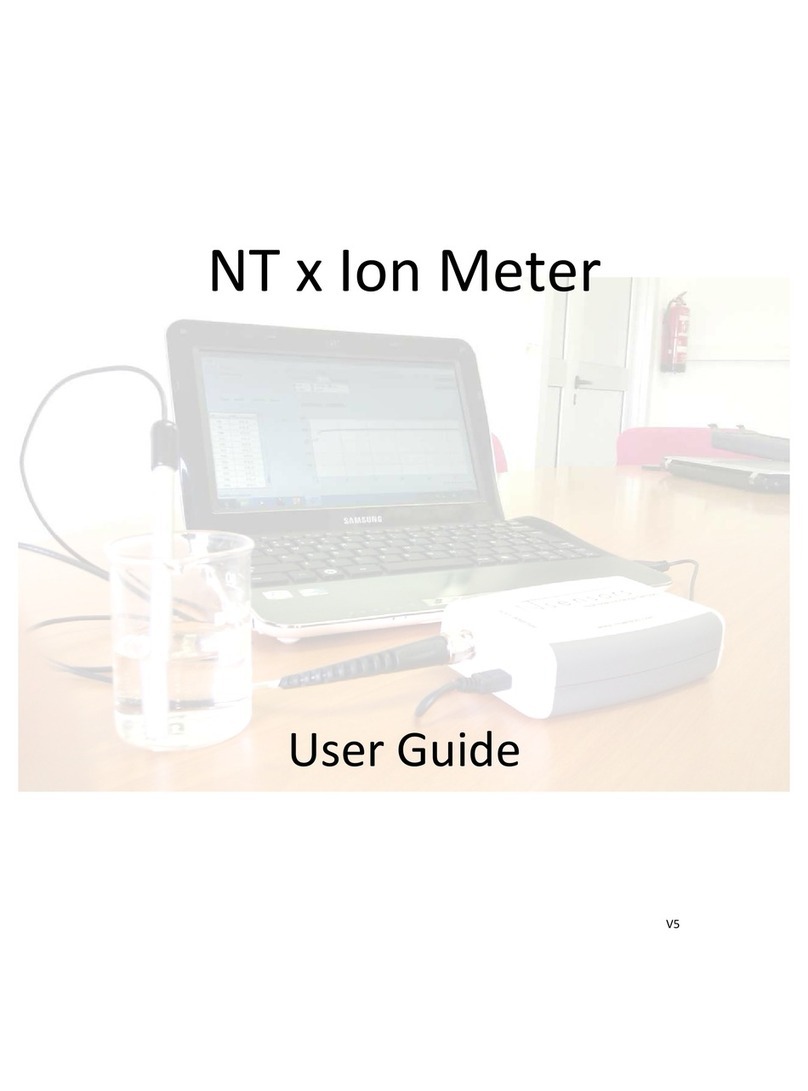
NT Sensors
NT Sensors NTx series user guide
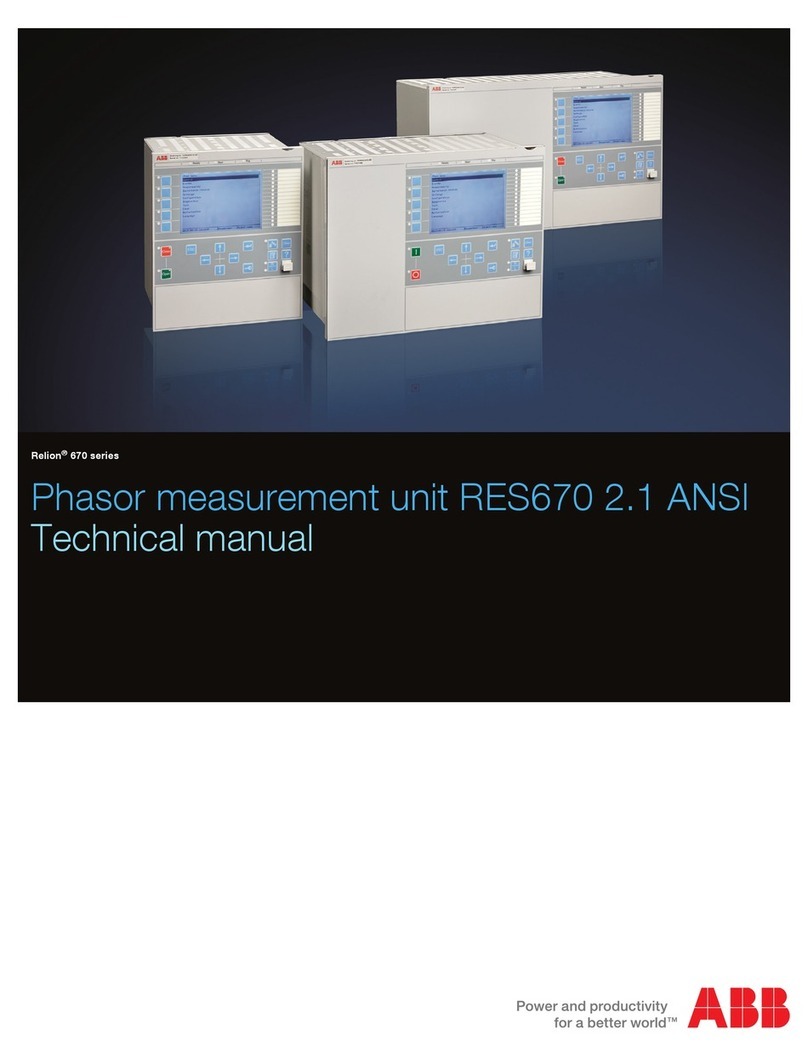
ABB
ABB Relion 670 Series RES670 Technical manual

Halma
Halma ALICAT SCIENTIFIC MB quick start guide
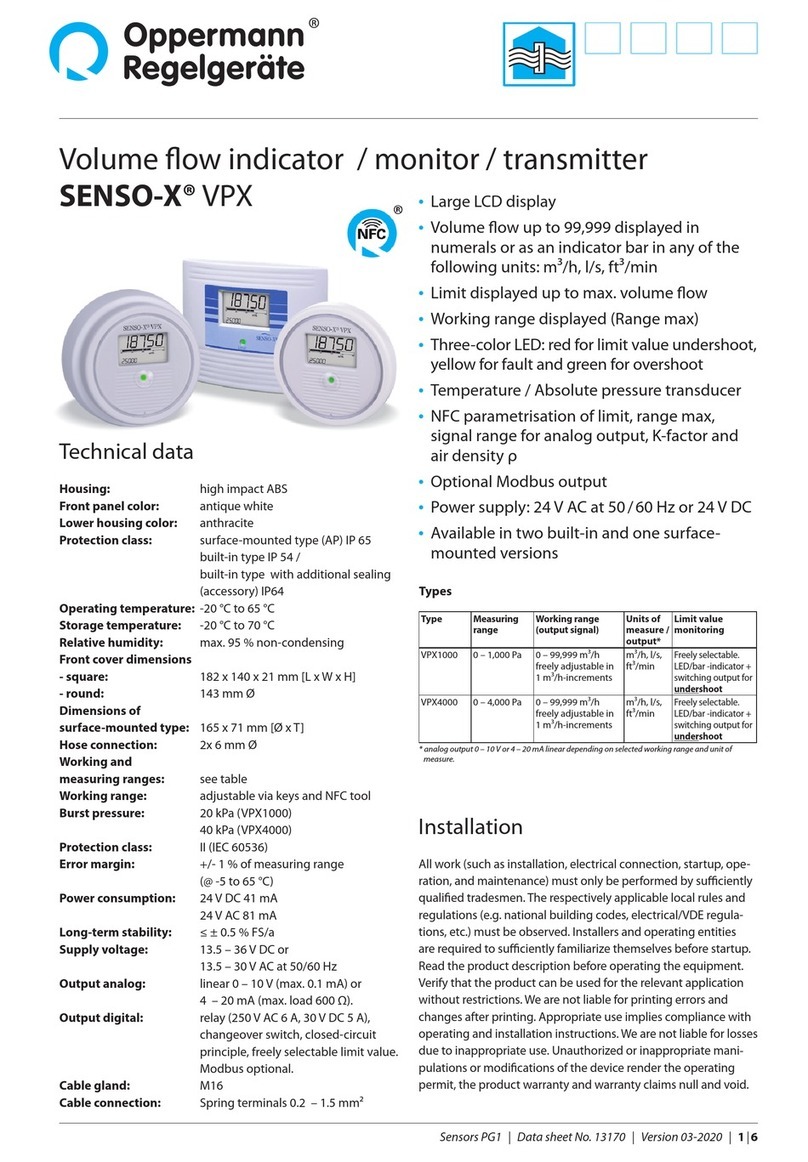
Oppermann Regelgeräte
Oppermann Regelgeräte SENSO-X VPX manual

Schaller Messtechnik
Schaller Messtechnik Humimeter BM1 user manual
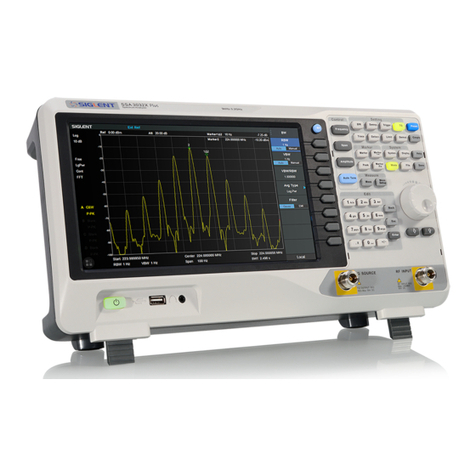
SIGLENT
SIGLENT SSA3000X Plus quick guide

